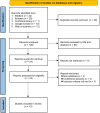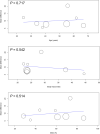The impact of esophageal device insertion on cuff pressure of endotracheal tube: a literature review and meta-analysis
- PMID: 36307502
- PMCID: PMC9616852
- DOI: 10.1038/s41598-022-21980-0
The impact of esophageal device insertion on cuff pressure of endotracheal tube: a literature review and meta-analysis
Abstract
The impact of intraoperative esophageal device insertion (EDI) on endotracheal tube (ET) cuff inflation pressure remains unclear. Electronic databases including Medline, Embase, Google scholar, Web of Science™ and Cochrane Central Register of Controlled Trials were searched for studies involving EDI after placement of ETs from inception to July 7, 2022. The primary outcome was risk of high cuff pressure, while the secondary outcomes were increases in cuff pressure following EDI. Difference between adults and children was investigated with subgroup analysis. There were ten eligible studies (observation study, n = 9, randomized controlled study, n = 1) involving a total of 468 participants. EDI notably increased the risk of high cuff pressure (n = 7, risk ratio: 12.82, 95% confidence interval: 4.9 to 33.52, subgroup analysis: p = 0.008). There were significant elevations in cuff pressure in adults and children both during (13.42 and 7.88 cmH2O, respectively, subgroup analysis: p = 0.15) and after (10.09 and 3.99 cmH2O, respectively, subgroup analysis: p = 0.0003) EDI. Our results revealed an over 12-fold increase in the risk of high endotracheal tube cuff pressure in patients, especially adults, receiving EDI under endotracheal anesthesia. There were significant increases in both adults and children despite a higher increase in the former after device insertion.
© 2022. The Author(s).
Conflict of interest statement
The authors declare no competing interests.
Figures








Similar articles
-
Continuous control of endotracheal cuff pressure and tracheal wall damage: a randomized controlled animal study.Crit Care. 2007;11(5):R109. doi: 10.1186/cc6142. Crit Care. 2007. PMID: 17915017 Free PMC article.
-
Development of appropriate procedures for inflation of endotracheal tube cuff in intubated patients.J Med Assoc Thai. 2007 Nov;90 Suppl 2:74-8. J Med Assoc Thai. 2007. PMID: 19238648
-
Verification of endotracheal tube placement using electrical stimulation through electrodes placed on the endotracheal tube cuff.Acta Anaesthesiol Scand. 2016 Jul;60(6):747-55. doi: 10.1111/aas.12696. Epub 2016 Feb 5. Acta Anaesthesiol Scand. 2016. PMID: 26846426
-
Effect of Tracheal Intubation Mode on Cuff Pressure During Retractor Splay and Dysphonia Recovery After Anterior Cervical Spine Surgery: A Randomized Clinical Trial.Spine (Phila Pa 1976). 2020 May 1;45(9):565-572. doi: 10.1097/BRS.0000000000003339. Spine (Phila Pa 1976). 2020. PMID: 31770329 Clinical Trial.
-
Do current methods for endotracheal tube cuff inflation create pressures above the recommended range? A review of the evidence.J Perioper Pract. 2013 Sep;23(9):198-201. doi: 10.1177/175045891302300904. J Perioper Pract. 2013. PMID: 24245362 Review.
Cited by
-
Association of preoperative prognostic nutritional index with risk of postoperative delirium: A systematic review and meta-analysis.Front Med (Lausanne). 2023 Jan 9;9:1017000. doi: 10.3389/fmed.2022.1017000. eCollection 2022. Front Med (Lausanne). 2023. PMID: 36698831 Free PMC article.
-
Efficacy of the Geriatric Nutritional Risk Index for Predicting Overall Survival in Patients with Head and Neck Cancer: A Meta-Analysis.Nutrients. 2023 Oct 12;15(20):4348. doi: 10.3390/nu15204348. Nutrients. 2023. PMID: 37892423 Free PMC article.
-
Comment to: Can ventral transabdominal preperitoneal achieve favorable outcomes in minimally invasive ventral hernia repair?Hernia. 2023 Dec;27(6):1623-1624. doi: 10.1007/s10029-023-02884-y. Epub 2023 Sep 15. Hernia. 2023. PMID: 37713140 No abstract available.
-
The Impact of Mesenteric Defect Closure on Internal Hernia Rates: Considerations on Follow-Up Duration.Obes Surg. 2023 Dec;33(12):4170-4171. doi: 10.1007/s11695-023-06879-7. Epub 2023 Oct 19. Obes Surg. 2023. PMID: 37856051 No abstract available.
-
Association of general anesthesia exposure with risk of postoperative delirium in patients receiving transcatheter aortic valve replacement: a meta-analysis and systematic review.Sci Rep. 2023 Sep 27;13(1):16241. doi: 10.1038/s41598-023-43548-2. Sci Rep. 2023. PMID: 37758810 Free PMC article.
References
-
- Tu HN, Saidi N, Leiutaud T, Bensaid S, Menival V, Duvaldestin P. Nitrous oxide increases endotracheal cuff pressure and the incidence of tracheal lesions in anesthetized patients. Anesth. Analg. 1999;89:187–190. - PubMed
-
- Poetker DM, Ettema SL, Blumin JH, Toohill RJ, Merati AL. Association of airway abnormalities and risk factors in 37 subglottic stenosis patients. Otolaryngol. Head Neck Surg. 2006;135:434–437. - PubMed
Publication types
MeSH terms
LinkOut - more resources
Full Text Sources

